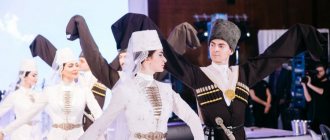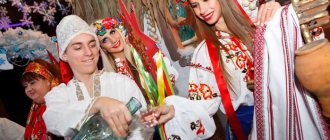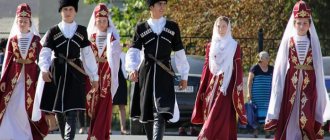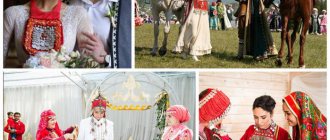An Azerbaijani wedding is perhaps the most important event in the life of every family in the country. In Azerbaijan, marriage is taken very seriously and preparation for the celebration takes a lot of effort and time from both the groom and the bride. The peculiarity of the country’s culture in this matter is that all stages of a couple’s relationship from choosing a bride to engagement have a number of their own unique traditions and characteristics. They are passed down across the country from generation to generation and make the culture unique.
Azerbaijani wedding traditions
From an early age, Azerbaijani girls are taught modesty and the need to stay away from male companies. Despite the freer customs of our time, the right to choose still remains with the man. When choosing a potential bride, a man must ask his parents for permission to marry a specific candidate. In Azerbaijan, the opinion of parents sometimes plays a decisive role in a young man’s choice of a future wife.
If the parents give consent, the young man should, according to tradition, ask his trusted relative to find out more about the potential chosen one. In particular, the groom will be interested in the material wealth and social level of the future bride. This factor influences whether a man will be strong enough to support a girl in the future. You will also learn such nuances as:
- health of the future woman;
- her level of education;
- housekeeping skills.
The only thing that often remains behind a veil of secrecy is age. In this country, engagement is allowed even if the girl is 14 years old.
Men
Since ancient times, Islamic norms have determined the dominant role of men. His task was to provide the family with housing and finances. The man did not take part in household chores and raising children. His word was law for his wife and was not disputed; women were treated with disdain. Men were allowed polygamy, levirate and sororate were practiced, and adultery was allowed. Azerbaijani men are distinguished by a calm and firm character, maintain a serious expression on their faces, and behave modestly and with dignity. They quickly make decisions and follow them clearly, without allowing doubts
They are sensitive to attacks on the honor of their family or their own, they keep their word, public opinion, status, and appearance are of particular importance
Main stages of matchmaking
After choosing a bride, the groom’s side sends relatives to the young woman’s house. With the consent of both parties, matchmaking will soon take place. The nuance of this ritual is that it is usually carried out in several stages, namely two. The first is called Small, the second - Big.
The first stage begins with the groom's father talking with the older generation of the bride. During the conversation, the opinion of each family member is listened to. Next, the matchmakers are sent directly to the girl’s house. Small matchmaking takes place in the presence of the groom's mother and a couple of other relatives as witnesses.
After this ceremony, the fathers of the two parties meet. The groom's father usually comes accompanied by three men. These can be both relatives and other significant people in the environment. It is he who reports on his son’s desire to marry the daughter of the other side’s family. The groom's father emphasizes the importance of the bride's opinion regarding marriage. If a girl is silent, this means consent. After which the matchmakers are removed.
The beginning of the Grand Stage is marked by a discussion by the head of the groom's family of the upcoming celebration and its details. Women from the young man’s side of the family again go to the bride and find out her opinion. If everything is in force, the day of arrival of the matchmakers is set. At the appointed time, matchmakers arrive and are given a place of honor in the house during the feast, usually at the head of the table. The bride is usually absent from the celebration, devoting time to communicating with her mother. If the conversation with relatives is a success, then the matchmakers take time to think about the details of the celebration.
During the second visit of the matchmakers to the bride's relatives, the matter takes place more solemnly. The table is set, a party is organized with a massive arrival of guests. The bride's mother should stay at home, but now her opinion should not be voiced, she should be silent. Ladies usually spend time visiting friends away from the hustle and bustle. After which, with mutual consent, the bride's father must bless the couple. And during the tea party, one of the girl’s friends should have time to run to her with congratulations and news.
The bride returns to the house after the festivities and the main part of the celebration are over. In Azerbaijan, the bride's crying on this day is considered a positive sign of a happy future.
Highlights
The large scale of the wedding feast is impressive. We can say that they begin to celebrate the union even at the matchmaking stage. This whole grandiose event requires significant expenses, so they begin to postpone children’s wedding in advance.
All pre-wedding efforts are divided into several stages:
- Search and selection of the bride by the groom.
- Matchmaking takes place in two stages.
- Engagement ceremony.
- Pre-wedding preparation with a lot of rituals.
- Wedding celebration.
- Post-wedding rituals.
Each item requires a serious approach and preliminary study of information about future relatives.
The groom chooses the bride, shows the girl he likes to his parents, and only after their approval begins the search for a matchmaker who will represent his interests in the bride’s family.
Girls in this country do not communicate with guys, always being in female company only. Therefore, often there is practically no time left to get to know the groom.
The decision always remains with the girl’s father; he, as the head of the family, determines whether the groom is suitable for his daughter. An important role here is played by the situation of the guy himself and his family, both financial and social.
Preparation for engagement and ceremony
Despite the displacement of a number of traditions, betrothal remains a ritual that has not changed in the country even after several hundred years. Like matchmaking, the betrothal ceremony includes two main stages.
The stage of the Small Betrothal begins after the groom's side receives the consent of the bride's parents for the marriage. Usually it does not take more than a month. To do this, relatives from the groom’s side must come to the young bride’s house. The lady at this time should be accompanied by a large number of friends.
The task of one of the ambassadors is engagement, that is, he must put a ring on the bride’s finger and cover her head with a special scarf. After which he is offered to eat a sweet, of which he must bite off half. The second, according to tradition, is delivered by the ambassador to the groom after the ritual is performed.
After the ambassadors leave, the housewives must set a sweet table, symbolizing the happiness and prosperity of the young family. The bride must then perform the bridal shower ceremony. She touches her hand to the head of each friend, and she, in turn, must try on her wedding ring. According to the superstition, the first one whose head the bride touches will soon get married. You can also see your betrothed thanks to a simple ritual: you had to put some sweet pastries under the pillow.
The Big Betrothal stage in the country begins a few months after the first, Small stage. Preparations for the event include preparing a sumptuous table and the help of relatives from the groom is not excluded. At this stage, it is customary to invite many guests, and not only relatives, but also neighbors, as well as distant friends.
The groom's friends gave gifts to the young bride, mainly those that could be useful to her in her new family. Only shoes were usually not given as a gift, since a little later this ritual was performed by the mother-in-law. Smaller gifts were placed on a special tray, which was covered with a special colorful cloth. Often the offering of gifts was accompanied by music. After which the ring was put back on the girl’s finger, and then a discussion followed about the size of the possible ransom. The money raised after the ceremony was spent on wedding preparations and the formation of a dowry.
A wedding in Azerbaijan requires the existence of a certain agreement if both families wish. According to it, the bride is entitled to an agreed amount of money in the event of a divorce from her husband in the future. From the engagement stage to the wedding celebration itself, it could take either a couple of months or several years. At the same time, the bride sat at home while waiting, and the groom’s relatives had to give her various necessary gifts, ranging from clothes to fruits. On the day of sacrifice, a bull was considered an ideal gift.
After the Big Betrothal stage, gifts to the groom's family must be given by the other party. The trick is to send gifts on the same trays on which the young woman previously received gifts. Gifts are distributed as follows.
- The first gift is intended for the groom himself.
- The second one is sent for men of the family circle.
- The third is for the ladies of the groom's family.
Other trays are designed to be filled with sweets and other nice little things. Now the responsibilities for collecting the festive table lie on the other side. But in this case the number of guests is expected to be smaller.
Story
In Antiquity, the territories of modern settlement of the nationality were occupied by nomadic tribes of the Caucasian and Caspian anthropological types. Later they formally united into Caucasian Albania, which was a union of 26 nomadic and semi-nomadic tribes living independently.
In the 4th century BC, Alexander the Great came to the region and founded the state of Media Atropatene. From it arose the name of the nation and the territorial boundaries of its main area of location. The state existed until the 8th century AD, when it was conquered by the powerful Arab Caliphate, which brought Islam, which quickly replaced Zoroastrianism, which had dominated here for centuries.
The next period to which researchers attribute the identification of Azerbaijanis as a nation is the 11th-13th centuries. Oguz tribes who spoke the Turkic language began to actively penetrate the region: the flow increased during the rule of the Tatar-Mongols. The finishing touch to the formation of the ethnic group was the Turkmens who came from Central Asia. By the 15th century, the inhabitants of the territories of modern Iran and Azerbaijan considered themselves one people and spoke the same language. From the 16th to the 18th centuries, the powerful Safavid dynasty ruled, during which the empire flourished, imposed tribute on neighboring regions and encroached on foreign territories. Then the state fell into decline and was divided into many khanates, for which the Russians, Iranians, Afghans, and the Ottoman Caliphate fought for the next century. After the revolution, the Azerbaijan SSR was formed, and the country's independence was restored in 1991. In Iran, representatives of the nation have long been subject to discrimination, but today many government posts are occupied by Azerbaijanis.
Pre-wedding preparation
In Azerbaijan, special attention is paid to this stage. Since the overall well-being in the future of a young family depends on the quality of its execution. Azerbaijani wedding traditions include an additional pre-wedding conversation between the families of both parties. The final decision on the formation of the wedding, down to the musical accompaniment and menu, is determined by the men.
In the interim period, other rituals related to the wedding are also carried out. It is interesting that the tradition of presenting gifts to the bride from the groom has been firmly preserved to the present day. In addition to other wardrobe details, a red scarf was considered a constant and important attribute one day. They also gave a rich dress and a lamb, whose horns were decorated with henna.
This tradition preserves the ritual of giving fruits and sweets on special trays, as in the matchmaking stage. Among other things, the bride is usually given henna, with which her hands are beautifully painted and her hair is also dyed.
Before the wedding ceremony, the bride's parents personally transport her personal belongings to the groom's home and also leave her dowry. The groom's mother should then thank the carrier by giving him a special gift. Afterwards, the bride's friends visit the house, clean it up and prepare it for the celebration. After all the events, the future mother-in-law of the bride also thanks them for their work.
A few days before the important ceremony, a ritual called Parcha Bichini is performed. On this day, a mentor is chosen for the future young bride. Another important nuance: the preparation of bread usually began a couple of days before the main celebration.
Making bread
Many Azerbaijani traditions are closely related to bread, because it is a symbol of abundance, prosperity and fertility. For example, before leaving her father’s house, an Azerbaijani bride had to walk around the baked bread three times so that this family would be prosperous without her. Also, in order to protect her future relatives from evil spirits and ensure abundance, the girl took a piece of bread from her parents’ nest to her future home.
Preparing bread for the upcoming wedding is a traditional custom of Azerbaijani families, carried out 2-3 days before the event.
- First, they choose the house where the bread will be baked - at the bride or groom's house.
- Then they try to make good dough, roll it out, and bake pita bread.
- When the treat is baked, the women thank the mistress of the house for the space provided, wishing them wealth and always hot bread on the table.
Bride's farewell ceremony
This tradition has also not undergone any special changes and is full of national symbolism.
First of all, guests from the groom’s side come and take the bride, accompanying the procession with dancing and singing. The bride herself is waiting in the wings behind closed doors, the keys to which guests will be able to receive immediately after they present the gift to the newlywed’s family. After presenting the gift to her parents, the girl is also blessed by tying a red ribbon around her waist. Next, they cover her head with a veil and take her out into the yard, where an impressive fire should already be lit. The tradition involves circling the bride 3 times around the fire, which symbolizes the future comfort and warmth of the new family. They usually throw a stone after them as a symbol of the fortress of the future home and family. Next comes the turn of water, which is dripped at the girl’s feet. This symbolizes a happy marriage without tears and disappointments.
Next, a plate is placed at the bride’s new house, which she breaks with her foot. Then it is important that the girl is given a male child into her arms. Thus, it is believed that after the ritual the first-born male will be born. Which is very important for Azerbaijani families.
Then, according to tradition, a young ram must be killed in front of the girl. This ritual is designed to help maintain happiness and harmony in marriage, as well as quickly integrate the girl into a new family, avoiding quarrels and disagreements with her husband’s relatives. Another ritual for harmony is the mother-in-law stroking her daughter-in-law’s hair during the wedding. As a sign of abundance, rice and sweets are sprinkled on the bride's head. Afterwards, the young bride is taken to a special decorated room, where she receives congratulations and warm wishes, including from large offspring.
Next, the young couple is sprinkled with rice again for greater financial well-being. In Azerbaijan, a tradition has been preserved, which consists of ransoming the bride, which is asked from the newlyweds on the way to the new house by the bridesmaids and other guests, blocking their way.
Number
The approximate number of Azerbaijanis who live around the world today is 50 million people. Surprisingly, most of them live in Iran - according to some sources, about 30 million. Next on the list is, in fact, Azerbaijan - 8.2 million. According to the 2010 census, the number of Azerbaijanis in Russia is 603,000. Experts believe that in fact there are three times more of them - about 2 million. The following states became the homeland for representatives of the nation:
- Türkiye - 3 million;
- USA - 1 million;
- Egypt - 850 thousand;
- Iraq - 800 thousand;
- Georgia - 600 thousand;
- Ukraine - 500 thousand;
- Afghanistan - 430 thousand;
- Kingdom of Jordan - 410 thousand;
- Pakistan - 350 thousand;
- Germany - 300 thousand;
- India - 300 thousand
What is the “Shah” of the bride
A shah is a special wooden decoration intended for the bride. It usually consists of several elements:
- mirrors;
- fabrics and candles;
- fruits;
- sweets.
Traditionally, the decoration is prepared by the best friend of the hero of the occasion. The girl’s house also hosts festivities and fun that accompanies the entire ritual. Afterwards, in the evening, the groom and his retinue come for the Shah, after which they go to the young woman’s house and give her the jewelry. Accompanying this entire celebration with shots from hunting rifles and songs, as well as dancing.
Tradition of a wedding for two houses
According to tradition, the celebration begins at the bride's house. At exactly 12 noon the sounds of the zurna are heard, which symbolize the beginning of the celebration. The younger generation helped the elders in serving the guests, who brought rich gifts in the form of gifts and money. Before accepting the gift, the bride's relatives had to put money in a special place, for the so-called cauldron.
After everyone donated money, it could be opened. Only relatives from the groom's side have the privilege to dance with the bridegroom.
At approximately 5 o'clock in the evening, relatives on the spouse's side must leave the house, and the holiday will continue without their participation.
After the holiday in one house, the celebration continues at the groom's. While the house is being prepared, the groom and his relatives go to pick up his betrothed. Parents do not take part in the procession. Those arriving for the bride are waiting for her at the door of the house. The groom must wait for the girl with the driver while the young mother gives gifts to the waiting guests. After which the groom joins his relatives.
Each relative of the bride must kiss her as a sign of farewell. Usually the last words are spoken by the father, who also kisses her forehead after the speech. It is the mother's responsibility to bless the young one. After the ceremony, the macaw heads to the man's house. In this case, the car with the bride usually travels in front, and the rest of the cortege follows it. Trips of this type usually do not pass without noise. Guests can make noise and fire their rifles, light torches and overtake each other. What sometimes attracts excessive attention from passers-by.
Before arriving at her new home, the bride must remove one shoe. This signal tells new relatives about the imminent arrival of the young woman. After the arrival of the cortege, the bull is slaughtered and its blood is marked on the foreheads of the young people. Afterwards, the groom sprinkles the chosen one’s head with rice, money, sweets and other little things to gain wealth and happiness.
After the bride enters the room, she does not have the opportunity to sit down immediately. The young woman has the right to sit down only after presenting a gift from her mother-in-law or a promise on her part to give it. The celebration is held inside the courtyard, where, according to tradition, those invited from the bride’s side arrive at 6 pm. Parents on the young side are allowed to spend a small amount of time at the holiday, after which they must leave.
Novruz holiday
This holiday does not have a clear translation; it is called the celebration of spring, renewal of nature, new year, etc. Unlike the traditional New Year, which the country celebrates on January 1, it is celebrated on March 21, the day of the spring equinox. But the celebration itself begins in advance and includes four more pre-holiday days.
The first of them is Su Chershenbe, the day of water renewal. According to ancient beliefs, on this day winter standing waters begin to move, snow in the mountains begins to melt and bring with them new life. According to tradition, Azerbaijanis get up at dawn, bring water from the source through which the first ray of the sun slid, sprinkle it on each other, and treat each other with sweets.
Odlu Chershenbe is the second Tuesday, it is dedicated to the Sun and its earthly likeness - fire. On this day, it is customary to light torches according to the number of family members, make fires, jump over the fire and believe that all past and future troubles will burn out in it without a trace. Only a minor “pure” boy can light this fire. It cannot be extinguished, especially with water; the fire must burn out on its own, after which the ashes are carried to the outskirts of the village.
This is followed by Torpag Chershenbe (earth day) and Ahyr Chershenbe, immediately preceding Novruz. People try to ward off sadness, avoid swearing, and do good; girls traditionally tell fortunes for the coming year.
March 21 is a non-working day; celebrations begin at dawn. Celebrations take place everywhere, national games and celebrations are held. Relatives come to visit with gifts, children collect sweets, and if you do not take into account local characteristics (national delicacies and types of wrestling, camel riding, etc.) and the lack of religious overtones, then outwardly all this resembles Christian Christmas.
Bride's outfit and hairstyle
The bride has a wide variety of wedding dress options, ranging from national dresses, which are richly decorated with stones and embroidery, to a white bride’s dress in the traditions of modern fashion. It is noteworthy that while modern dresses have open sleeves, traditional Azerbaijani versions have closed arms, symbolizing the modesty of the bride. The main details of the image are the veil and red ribbon, which, as mentioned above, is traditionally belted around the waist.
Traditional hairstyles for both the bride and the girls present at the celebration deserve special attention. The abundance of options is complemented by the natural beauty and thickness of Azerbaijani hair. The main task of a hairdresser is to emphasize the natural beauty of hair with the help of a well-chosen hairstyle. In rare cases, the bride’s hair is completely hidden with a headdress or veil, but this nuance does not diminish the beauty and grace, but rather, on the contrary, emphasizes it.
Wedding dances and music
The importance of the wedding is emphasized by the dancing that has accompanied the ceremony from time immemorial. Usually the wedding is accompanied by folk songs; if families have enough finances, they invite musicians of a higher level.
Most guests learn traditional folk dances and songs from early childhood and happily perform them at wedding celebrations, showing their education and respect for customs. Music accompanies most of the wedding and sometimes plays until the morning, even if the celebration is held on Russian territory.
Traditions and customs after the wedding celebration
There are many rituals and traditions after a wedding in Azerbaijan. For example, relatives on both sides have the right to look at the sheet after the first wedding night in order to make sure of the purity and innocence of the betrothed. After performing the ritual, the hosts should treat the guests to pilaf. After the wedding, the duties of the mother-in-law include presenting various treats to the newlyweds for 3 days.
After the wedding, the bride is not allowed to see her father-in-law for two weeks, after which the mother-in-law sets the festive table, and the father-in-law calls the bride and gives her a personal gift. This ritual symbolizes the acceptance of the daughter-in-law into the new family by the older generation of the husband.
After a certain number of months, the young mother has the right to visit her daughter’s new family with her relatives. The first meeting with parents is unique in its own way. After 40 days from the date of the celebration, the newlyweds have the opportunity to personally visit the bride’s family. The parents of the newly-made bride must set the table, and she herself can, if she wishes, stay for a few days in the old house.
After the completion of the rituals, the time restriction is lifted and the girl can visit her family whenever she wants. Often, relatives of both parties invite the newlyweds to visit to exchange experiences and gifts. Modern traditions provide for the possibility of photographs with the bride and groom, and also allow the newlyweds to sit at the table with the invited guests.
An Azerbaijani wedding is a unique event, the presence of which will help you understand the ancient traditions and rituals of this unique culture.











